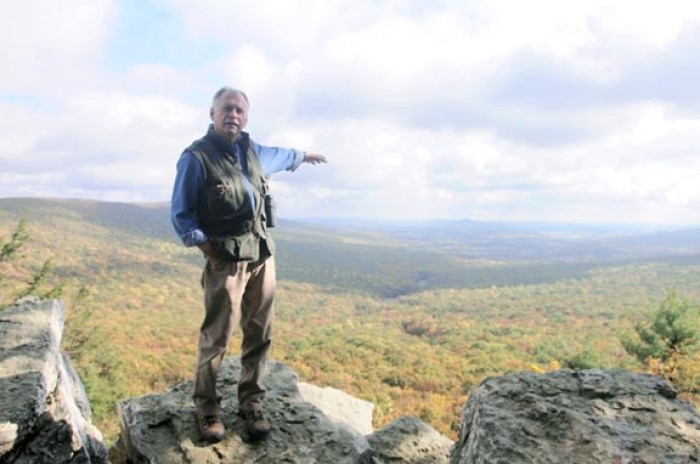Director of Conservation Science to retire
Posted on July 03, 2018 in Science

Dr. Keith L. Bildstein, Sarkis Acopian Director of Conservation Science at Hawk Mountain Sanctuary, the world’s oldest and largest raptor conservation organization in the world, has retired. Bildstein is a globally recognized expert on raptor migration science.
“I’ve had the chance to do what I love for more than three decades. It is time to watch the next generation of raptor biologists take the reins at Hawk Mountain,” Bildstein said.
Keith’s first visit to Hawk Mountain as a Muhlenberg College undergraduate in 1969 helped inspire him to pursue a career in raptor biology. He went on to receive his M.S. and Ph.D. in zoology from The Ohio State University in the 1976 and 1978, and he joined Hawk Mountain as its director of research in 1992.
“Keith will always be part of the fabric that makes Hawk Mountain what it is today. His remarkable contributions to raptor conservation, and in growing the Sanctuary’s conservation program globally, ensures a lasting legacy,” said Sanctuary President Sean Grace.
During the 1990s, Bildstein directed Hawks Aloft Worldwide, a global conservation initiative with more than 800 collaborators that produced Raptor Watch, the first-ever global directory of raptor migration watchsites. Raptor Watch compiled information on 388 watchsites in more than 100 countries. Its publication capped over a decade of work, and established the Sanctuary as an international leader in raptor conservation.
In the late 1990s, his vision for a biological field station and training site attracted the attention of the late Lehigh Valley philanthropist and businessman Sarkis Acopian, who would become Bildstein’s friend in raptor conservation. With the largest gift in Hawk Mountain history, Acopian provided funds to build and equip the Acopian Center for Conservation Learning, a world-class, three-building facility at the base of the Sanctuary, that now serves as headquarters for Hawk Mountain research and graduate-level training programs. Two years later, Mr. Acopian endowed the Sanctuary’s directorship in conservation science.
With the infrastructure provided at the Acopian Center, Keith successfully expanded the Sanctuary’s international training program, and attracted to Hawk Mountain mid- and senior-level scientists, graduate students, and a cadre of promising young conservationists. In 2006, he published Migrating Raptors of the World: Their Ecology and Conservation, which served as a textbook for the Sanctuary’s training program, and two years later a lab manual, Raptor Research and Management Techniques, which he co-edited with Dr. David Bird of McGill University.
“Keith was the driving force and the most passionate advocate for Hawk Mountain’s internationally acclaimed training program, and the results speak for themselves. He essentially has armed the globe with a multi-hundred conservation-scientist force of fully-trained and highly effective raptor biologists,” says Grace.
Recognized globally, Keith has accumulated numerous international accolades. In 2010, he received a Lifetime Achievement Award from Fundacion Migres at the First International Bird Migration and Global Change conference in southern Spain, and in 2015, was named a Fellow of the American Association for the Advancement of Science.
He authored in 2016 Raptors: The Curious Nature of Diurnal Birds of Prey, which has been called a long-overdue modern textbook for the general public and raptor biologists. Earlier this year, the board of directors selected him as recipient of the Hawk Mountain Warden Award for his long-term and extensive contributions to raptor-migration science and dedication to training the next generation of raptor conservationists at the Sanctuary.
“Hawk Mountain is truly the ‘cradle of raptor conservation.’ I leave it in good hands, and trust that it will continue to set the global standard for raptor conservation well into the future,” says Bildstein.
